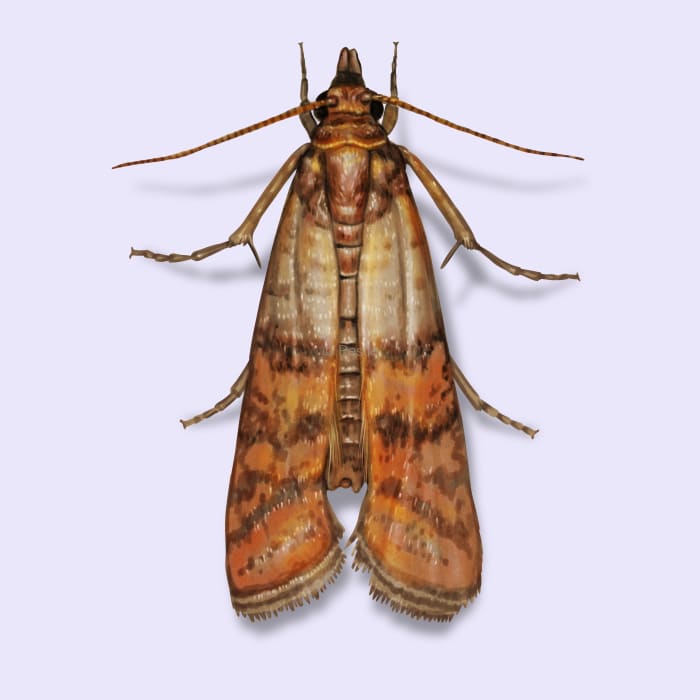How to identify and get rid of Indian meal moth

Don't let Indian meal moths turn your pantry into a buffet
There's nothing like opening your pantry and noticing a few fluttering moths. That's nothing to worry about, right?
While adult Indian meal moths may not be causing any problems, their larvae can make a mess of your dried and stored food. They might just be the culprit behind those mysterious holes in your flour bags or the strange webbing in your cereal boxes.
Indian meal moths, also known as pantry moths, love laying their eggs on cereals, fruit, and grain products. The larvae are known to bite through plastic and cardboard to get at the buffet you have in your pantry.
The larvae also can travel away from where they made their mess. That means if you find an infestation in your bag of flour on the middle shelf, some larvae could be pupating one shelf up without you noticing it!
How to identify Indian meal moths
Spotting an Indian meal moth involves looking for small, two-toned moths fluttering around your pantry or kitchen. They're not big, but their distinctive tan and coppery wings make them stand out. When at rest, they fold their wings in a roof-like pitch. Also, they have fringes on the margins of their wings.
If you see tiny caterpillars in your dry goods or find web-like material in your food packages, that's a sign these moths have made themselves at home. The larvae are white and very small. As they grow, they often spin a web trail as they crawl. They will then spin a thin cocoon attached to a surface when they pupate.
How big are Indian meal moths?
Adult Indian meal moths have a wingspan of about 5/8 inches wide, and the larvae grow to be ½ inch long.
What other pest looks like an Indian meal moth?
They might be confused with clothes moths, but clothes moths are smaller and lack the distinctive wing coloring. Clothes moths also avoid light, while Indian meal moths are often seen flying towards light sources.
Additionally, Indian meal moths may be confused with almond moths, raisin moths, and the Mediterranean flour moth. Look for the copper colors on the Indian meal moth.
Where do indian meal moths live?
You can find Indian meal moths all over the United States. Look for them in your pantries or where you store dried foods, flour, and cereals. They can also feed on dried pet food too.
How to get rid of Indian meal moths
One of the best ways to get rid of Indian meal moths is to not get them in the first place! That means properly storing your flour, cereals, and dried goods in insect-proof containers. Also, make sure you clean up any spills in your cabinets or pantry.
But what if you already have Indian meal moths ransacking your pantry? What can you do?
Here are a few tips to get rid of Indian meal moths: -Inspect and dispose: Check all food packages for signs of infestation and dispose of anything contaminated.
- Freeze infestations: Infested packages can be frozen to kill any larvae or eggs before disposing of them
- Vacuum and clean: Thoroughly vacuum pantry shelves and wipe them down with vinegar or soapy water to remove larvae and eggs.
Treat indianmeal moths with Pestie
If you're still having trouble keeping indianmeal moths away, the best option is to use a pro-grade, effective pest control solution like Pestie.
Pestie is a do-it-yourself pest control solution that's specially designed to keep indianmeal moths and other pests away from your home.
With Pestie, you can rest easy knowing that your living space is protected and free of creepy crawlies. And the best part? It's designed for people, pets, and the planet, so you can say goodbye to harsh chemicals and hello to peace of mind!
- Save hundreds compared to traditional annual pest plans
- People, pet, and planet-friendly
- Pro-grade customized formulas
Quick facts
- Scientific name
Plodia interpunctella
- Other common names
Weevil Moths, Pantry Moths, Flour Moths, Grain Moths
- Colors
Reddish-brown
- Life span
2 months
- Diet
Larvae eat cereals, flour, bread, pasta, seeds, dried fruit, nuts
How dangerous are Indianmeal Moths?
Low danger risk
While not harmful to humans or pets, they can contaminate food products, leading to food waste and frustration.
Indian meal moth eggs can delay hatching until the temperature is right, and larvae can slow their growth if temperatures get too cool.








